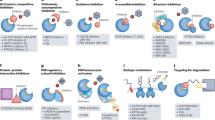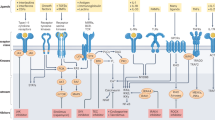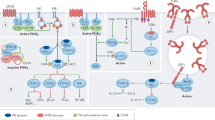Abstract
Lymphocyte activation must be tightly regulated to ensure sufficient immunity to pathogens and prevent autoimmunity. Protein tyrosine phosphatases (PTPs) serve critical roles in this regulation by controlling the functions of key receptors and intracellular signaling molecules in lymphocytes. In some cases, PTPs inhibit lymphocyte activation, whereas in others they promote it. Here we discuss recent progress in elucidating the roles and mechanisms of action of PTPs in lymphocyte activation. We also review the accumulating evidence that genetic alterations in PTPs are involved in human autoimmunity.
This is a preview of subscription content, access via your institution
Access options
Subscribe to this journal
Receive 12 print issues and online access
$209.00 per year
only $17.42 per issue
Buy this article
- Purchase on Springer Link
- Instant access to full article PDF
Prices may be subject to local taxes which are calculated during checkout




Similar content being viewed by others
References
Murphy, K., Travers, P., Walport, M. & Janeway, C. Immunobiology, 7th Edition (Garland Science, New York, 2008).
Samelson, L.E. Signal transduction mediated by the T cell antigen receptor: the role of adapter proteins. Annu. Rev. Immunol. 20, 371–394 (2002).
Lanier, L.L. NK cell recognition. Annu. Rev. Immunol. 23, 225–274 (2005).
Raulet, D.H. Roles of the NKG2D immunoreceptor and its ligands. Nat. Rev. Immunol. 3, 781–790 (2003).
Cambier, J.C. Antigen and Fc receptor signaling. The awesome power of the immunoreceptor tyrosine-based activation motif (ITAM). J. Immunol. 155, 3281–3285 (1995).
Veillette, A. SLAM-family receptors: immune regulators with or without SAP-family adaptors. Cold Spring Harb. Perspect. Biol. 2, a002469 (2010).
Weiss, A. T cell antigen receptor signal transduction: a tale of tails and cytoplasmic protein-tyrosine kinases. Cell 73, 209–212 (1993).
Jordan, M.S., Singer, A.L. & Koretzky, G.A. Adaptors as central mediators of signal transduction in immune cells. Nat. Immunol. 4, 110–116 (2003).
Horejsí, V., Zhang, W. & Schraven, B. Transmembrane adaptor proteins: organizers of immunoreceptor signalling. Nat. Rev. Immunol. 4, 603–616 (2004).
Schindler, C., Levy, D.E. & Decker, T. JAK-STAT signaling: from interferons to cytokines. J. Biol. Chem. 282, 20059–20063 (2007).
Mustelin, T., Vang, T. & Bottini, N. Protein tyrosine phosphatases and the immune response. Nat. Rev. Immunol. 5, 43–57 (2005).
Pao, L.I., Badour, K., Siminovitch, K.A. & Neel, B.G. Nonreceptor protein-tyrosine phosphatases in immune cell signaling. Annu. Rev. Immunol. 25, 473–523 (2007).
Vang, T. et al. Protein tyrosine phosphatases in autoimmunity. Annu. Rev. Immunol. 26, 29–55 (2008).
Hermiston, M.L., Xu, Z. & Weiss, A. CD45: a critical regulator of signaling thresholds in immune cells. Annu. Rev. Immunol. 21, 107–137 (2003).
Zikherman, J. & Weiss, A. Alternative splicing of CD45: the tip of the iceberg. Immunity 29, 839–841 (2008).
Desai, D.M., Sap, J., Silvennoinen, O., Schlessinger, J. & Weiss, A. The catalytic activity of the CD45 membrane-proximal phosphatase domain is required for TCR signaling and regulation. EMBO J. 13, 4002–4010 (1994).
Wang, Y. & Johnson, P. Expression of CD45 lacking the catalytic protein tyrosine phosphatase domain modulates Lck phosphorylation and T cell activation. J. Biol. Chem. 280, 14318–14324 (2005).
Majeti, R. et al. An inactivating point mutation in the inhibitory wedge of CD45 causes lymphoproliferation and autoimmunity. Cell 103, 1059–1070 (2000).
Nam, H.J., Poy, F., Saito, H. & Frederick, C.A. Structural basis for the function and regulation of the receptor protein tyrosine phosphatase CD45. J. Exp. Med. 201, 441–452 (2005).
Koretzky, G.A., Picus, J., Thomas, M.L. & Weiss, A. Tyrosine phosphatase CD45 is essential for coupling T-cell antigen receptor to the phosphatidyl inositol pathway. Nature 346, 66–68 (1990). The authors show that CD45 is essential for TCR-mediated signaling and T cell activation.
Kishihara, K. et al. Normal B lymphocyte development but impaired T cell maturation in CD45-exon6 protein tyrosine phosphatase-deficient mice. Cell 74, 143–156 (1993). This manuscript shows that CD45 is necessary for T cell development but not for B cell development.
Byth, K.F. et al. CD45-null transgenic mice reveal a positive regulatory role for CD45 in early thymocyte development, in the selection of CD4+CD8+ thymocytes, and B cell maturation. J. Exp. Med. 183, 1707–1718 (1996).
Cahir McFarland, E.D. et al. Correlation between Src family member regulation by the protein-tyrosine-phosphatase CD45 and transmembrane signaling through the T-cell receptor. Proc. Natl. Acad. Sci. USA 90, 1402–1406 (1993).
Ostergaard, H.L. et al. Expression of CD45 alters phosphorylation of the lck-encoded tyrosine protein kinase in murine lymphoma T-cell lines. Proc. Natl. Acad. Sci. USA 86, 8959–8963 (1989). This report, and ref. 25, shows that CD45 specifically dephosphorylates the inhibitory tyrosine of Src family kinases.
Mustelin, T., Coggeshall, K.M. & Altman, A. Rapid activation of the T-cell tyrosine protein kinase pp56lck by the CD45 phosphotyrosine phosphatase. Proc. Natl. Acad. Sci. USA 86, 6302–6306 (1989).
Sieh, M., Bolen, J.B. & Weiss, A. CD45 specifically modulates binding of Lck to a phosphopeptide encompassing the negative regulatory tyrosine of Lck. EMBO J. 12, 315–321 (1993).
Seavitt, J.R. et al. Expression of the p56(Lck) Y505F mutation in CD45-deficient mice rescues thymocyte development. Mol. Cell. Biol. 19, 4200–4208 (1999).
Zikherman, J. et al. CD45-Csk phosphatase-kinase titration uncouples basal and inducible T cell receptor signaling during thymic development. Immunity 32, 342–354 (2010).
Baker, M. et al. Development of T-leukaemias in CD45 tyrosine phosphatase-deficient mutant lck mice. EMBO J. 19, 4644–4654 (2000).
D'Oro, U. & Ashwell, J.D. Cutting edge: the CD45 tyrosine phosphatase is an inhibitor of Lck activity in thymocytes. J. Immunol. 162, 1879–1883 (1999).
Benatar, T. et al. Immunoglobulin-mediated signal transduction in B cells from CD45-deficient mice. J. Exp. Med. 183, 329–334 (1996).
Weaver, C.T., Pingel, J.T., Nelson, J.O. & Thomas, M.L. CD8+ T-cell clones deficient in the expression of the CD45 protein tyrosine phosphatase have impaired responses to T-cell receptor stimuli. Mol. Cell. Biol. 11, 4415–4422 (1991).
Justement, L.B., Campbell, K.S., Chien, N.C. & Cambier, J.C. Regulation of B cell antigen receptor signal transduction and phosphorylation by CD45. Science 252, 1839–1842 (1991).
Zhu, J.W., Brdicka, T., Katsumoto, T.R., Lin, J. & Weiss, A. Structurally distinct phosphatases CD45 and CD148 both regulate B cell and macrophage immunoreceptor signaling. Immunity 28, 183–196 (2008). This publication shows that CD45 and CD148 cooperate to promote BCR signaling, B cell activation and B cell development.
Katagiri, T., Ogimoto, M., Hasegawa, K., Mizuno, K. & Yakura, H. Selective regulation of Lyn tyrosine kinase by CD45 in immature B cells. J. Biol. Chem. 270, 27987–27990 (1995).
Katagiri, T. et al. CD45 negatively regulates lyn activity by dephosphorylating both positive and negative regulatory tyrosine residues in immature B cells. J. Immunol. 163, 1321–1326 (1999).
Zikherman, J., Doan, K., Parameswaran, R., Raschke, W. & Weiss, A. Quantitative differences in CD45 expression unmask functions for CD45 in B-cell development, tolerance, and survival. Proc. Natl. Acad. Sci. USA 109, E3–E12 (2012).
Hesslein, D.G., Takaki, R., Hermiston, M.L., Weiss, A. & Lanier, L.L. Dysregulation of signaling pathways in CD45-deficient NK cells leads to differentially regulated cytotoxicity and cytokine production. Proc. Natl. Acad. Sci. USA 103, 7012–7017 (2006).
Huntington, N.D., Xu, Y., Nutt, S.L. & Tarlinton, D.M. A requirement for CD45 distinguishes Ly49D-mediated cytokine and chemokine production from killing in primary natural killer cells. J. Exp. Med. 201, 1421–1433 (2005).
Mason, L.H., Willette-Brown, J., Taylor, L.S. & McVicar, D.W. Regulation of Ly49D/DAP12 signal transduction by Src-family kinases and CD45. J. Immunol. 176, 6615–6623 (2006).
Johnson, K.G., Bromley, S.K., Dustin, M.L. & Thomas, M.L. A supramolecular basis for CD45 tyrosine phosphatase regulation in sustained T cell activation. Proc. Natl. Acad. Sci. USA 97, 10138–10143 (2000).
Irles, C. et al. CD45 ectodomain controls interaction with GEMs and Lck activity for optimal TCR signaling. Nat. Immunol. 4, 189–197 (2003).
Davis, S.J. & van der Merwe, P.A. The kinetic-segregation model: TCR triggering and beyond. Nat. Immunol. 7, 803–809 (2006).
Batista, F.D., Iber, D. & Neuberger, M.S. B cells acquire antigen from target cells after synapse formation. Nature 411, 489–494 (2001).
Xu, Z. & Weiss, A. Negative regulation of CD45 by differential homodimerization of the alternatively spliced isoforms. Nat. Immunol. 3, 764–771 (2002).
Jacobsen, M. et al. A point mutation in PTPRC is associated with the development of multiple sclerosis. Nat. Genet. 26, 495–499 (2000).
Barcellos, L.F. et al. PTPRC (CD45) is not associated with the development of multiple sclerosis in U.S. patients. Nat. Genet. 29, 23–24 (2001).
Hermiston, M.L., Zikherman, J. & Zhu, J.W. CD45, CD148, and Lyp/Pep: critical phosphatases regulating Src family kinase signaling networks in immune cells. Immunol. Rev. 228, 288–311 (2009).
Stepanek, O. et al. Regulation of Src family kinases involved in T cell receptor signaling by protein-tyrosine phosphatase CD148. J. Biol. Chem. 286, 22101–22112 (2011).
Tangye, S.G. et al. Negative regulation of human T cell activation by the receptor-type protein tyrosine phosphatase CD148. J. Immunol. 161, 3803–3807 (1998).
Lin, J. & Weiss, A. The tyrosine phosphatase CD148 is excluded from the immunologic synapse and down-regulates prolonged T cell signaling. J. Cell Biol. 162, 673–682 (2003).
Burn, G.L., Svensson, L., Sanchez-Blanco, C., Saini, M. & Cope, A.P. Why is PTPN22 a good candidate susceptibility gene for autoimmune disease? FEBS Lett. 585, 3689–3698 (2011).
Vang, T., Miletic, A.V., Bottini, N. & Mustelin, T. Protein tyrosine phosphatase PTPN22 in human autoimmunity. Autoimmunity 40, 453–461 (2007).
Veillette, A., Rhee, I., Souza, C.M. & Davidson, D. PEST family phosphatases in immunity, autoimmunity, and autoinflammatory disorders. Immunol. Rev. 228, 312–324 (2009).
Cloutier, J.F. & Veillette, A. Association of inhibitory tyrosine protein kinase p50csk with protein tyrosine phosphatase PEP in T cells and other hemopoietic cells. EMBO J. 15, 4909–4918 (1996). The authors show that PTPN22 (PEP in mice) is associated with the inhibitory protein tyrosine kinase Csk in cells of the immune response.
Veillette, A., Latour, S. & Davidson, D. Negative regulation of immunoreceptor signaling. Annu. Rev. Immunol. 20, 669–707 (2002).
Cloutier, J.F. & Veillette, A. Cooperative inhibition of T-cell antigen receptor signaling by a complex between a kinase and a phosphatase. J. Exp. Med. 189, 111–121 (1999). This manuscript shows that PTPN22 (PEP in mice) cooperates with Csk to inhibit TCR signaling and T cell activation, through its ability to inactivate Src family kinases and certain Src family kinase substrates.
Gjörloff-Wingren, A., Saxena, M., Williams, S., Hammi, D. & Mustelin, T. Characterization of TCR-induced receptor-proximal signaling events negatively regulated by the protein tyrosine phosphatase PEP. Eur. J. Immunol. 29, 3845–3854 (1999).
Wu, S., Bottini, M., Rickert, R.C., Mustelin, T. & Tautz, L. In silico screening for PTPN22 inhibitors: active hits from an inactive phosphatase conformation. ChemMedChem 4, 440–444 (2009).
Gregorieff, A., Cloutier, J.F. & Veillette, A. Sequence requirements for association of protein-tyrosine phosphatase PEP with the Src homology 3 domain of inhibitory tyrosine protein kinase p50(csk). J. Biol. Chem. 273, 13217–13222 (1998).
Ghose, R., Shekhtman, A., Goger, M.J., Ji, H. & Cowburn, D. A novel, specific interaction involving the Csk SH3 domain and its natural ligand. Nat. Struct. Biol. 8, 998–1004 (2001).
Hasegawa, K. et al. PEST domain-enriched tyrosine phosphatase (PEP) regulation of effector/memory T cells. Science 303, 685–689 (2004). This study provides genetic evidence in mice that PTPN22 (PEP) is a negative regulator of TCR signaling and T cell activation.
Bottini, N. et al. A functional variant of lymphoid tyrosine phosphatase is associated with type I diabetes. Nat. Genet. 36, 337–338 (2004). This report shows that a PTPN22 polymorphism (R620W) is associated with a greater incidence of certain autoimmune diseases in humans.
Vang, T. et al. Autoimmune-associated lymphoid tyrosine phosphatase is a gain-of-function variant. Nat. Genet. 37, 1317–1319 (2005).
Rieck, M. et al. Genetic variation in PTPN22 corresponds to altered function of T and B lymphocytes. J. Immunol. 179, 4704–4710 (2007).
Aarnisalo, J. et al. Reduced CD4+ T cell activation in children with type 1 diabetes carrying the PTPN22/Lyp 620Trp variant. J. Autoimmun. 31, 13–21 (2008).
Habib, T. et al. Altered B cell homeostasis is associated with type I diabetes and carriers of the PTPN22 allelic variant. J. Immunol. 188, 487–496 (2012).
Menard, L. et al. The PTPN22 allele encoding an R620W variant interferes with the removal of developing autoreactive B cells in humans. J. Clin. Invest. 121, 3635–3644 (2011).
Arechiga, A.F. et al. Cutting edge: the PTPN22 allelic variant associated with autoimmunity impairs B cell signaling. J. Immunol. 182, 3343–3347 (2009).
Zikherman, J. et al. PTPN22 deficiency cooperates with the CD45 E613R allele to break tolerance on a non-autoimmune background. J. Immunol. 182, 4093–4106 (2009).
Zhang, J. et al. The autoimmune disease-associated PTPN22 variant promotes calpain-mediated Lyp/Pep degradation associated with lymphocyte and dendritic cell hyperresponsiveness. Nat. Genet. 43, 902–907 (2011).
Lorenz, U. SHP-1 and SHP-2 in T cells: two phosphatases functioning at many levels. Immunol. Rev. 228, 342–359 (2009).
Daëron, M., Jaeger, S., Du Pasquier, L. & Vivier, E. Immunoreceptor tyrosine-based inhibition motifs: a quest in the past and future. Immunol. Rev. 224, 11–43 (2008).
Stefanová, I. et al. TCR ligand discrimination is enforced by competing ERK positive and SHP-1 negative feedback pathways. Nat. Immunol. 4, 248–254 (2003).
Shultz, L.D. et al. Mutations at the murine motheaten locus are within the hematopoietic cell protein-tyrosine phosphatase (Hcph) gene. Cell 73, 1445–1454 (1993).
Tsui, H.W., Siminovitch, K.A., de Souza, L. & Tsui, F.W. Motheaten and viable motheaten mice have mutations in the haematopoietic cell phosphatase gene. Nat. Genet. 4, 124–129 (1993).
Pao, L.I. et al. B cell–specific deletion of protein-tyrosine phosphatase Shp1 promotes B-1a cell development and causes systemic autoimmunity. Immunity 27, 35–48 (2007).
Fowler, C.C., Pao, L.I., Blattman, J.N. & Greenberg, P.D. SHP-1 in T cells limits the production of CD8 effector cells without impacting the formation of long-lived central memory cells. J. Immunol. 185, 3256–3267 (2010).
Kwon, J. et al. Receptor-stimulated oxidation of SHP-2 promotes T-cell adhesion through SLP-76-ADAP. EMBO J. 24, 2331–2341 (2005).
Frearson, J.A. & Alexander, D.R. The phosphotyrosine phosphatase SHP-2 participates in a multimeric signaling complex and regulates T cell receptor (TCR) coupling to the Ras/mitogen-activated protein kinase (MAPK) pathway in Jurkat T cells. J. Exp. Med. 187, 1417–1426 (1998).
Salmond, R.J., Huyer, G., Kotsoni, A., Clements, L. & Alexander, D.R. The src homology 2 domain-containing tyrosine phosphatase 2 regulates primary T-dependent immune responses and Th cell differentiation. J. Immunol. 175, 6498–6508 (2005).
Doody, K.M., Bourdeau, A. & Tremblay, M.L. T-cell protein tyrosine phosphatase is a key regulator in immune cell signaling: lessons from the knockout mouse model and implications in human disease. Immunol. Rev. 228, 325–341 (2009).
You-Ten, K.E. et al. Impaired bone marrow microenvironment and immune function in T cell protein tyrosine phosphatase-deficient mice. J. Exp. Med. 186, 683–693 (1997).
Dupuis, M., De Jesus Ibarra-Sanchez, M., Tremblay, M.L. & Duplay, P. Gr-1+ myeloid cells lacking T cell protein tyrosine phosphatase inhibit lymphocyte proliferation by an IFN-g- and nitric oxide-dependent mechanism. J. Immunol. 171, 726–732 (2003).
Wiede, F. et al. T cell protein tyrosine phosphatase attenuates T cell signaling to maintain tolerance in mice. J. Clin. Invest. 121, 4758–4774 (2011). This group shows that PTPN2 (T cell–protein tyrosine phosphatase) is a negative regulator of TCR and cytokine receptor signaling in T cells and that it is involved in the control of T cell tolerance.
Burton, P.R. et al. Genome-wide association study of 14,000 cases of seven common diseases and 3,000 shared controls. Nature 447, 661–678 (2007). This paper describes a polymorphism in PTPN2 that is associated with a greater incidence of autoimmune diseases in humans.
Espino-Paisan, L. et al. A polymorphism in PTPN2 gene is associated with an earlier onset of type 1 diabetes. Immunogenetics 63, 255–258 (2011).
Thompson, S.D. et al. The susceptibility loci juvenile idiopathic arthritis shares with other autoimmune diseases extend to PTPN2, COG6, and ANGPT1. Arthritis Rheum. 62, 3265–3276 (2010).
Festen, E.A. et al. A meta-analysis of genome-wide association scans identifies IL18RAP, PTPN2, TAGAP, and PUS10 as shared risk loci for Crohn's disease and celiac disease. PLoS Genet. 7, e1001283 (2011).
Morgan, A.R. et al. PTPN2 but not PTPN22 is associated with Crohn's disease in a New Zealand population. Tissue Antigens 76, 119–125 (2010).
Long, S.A. et al. An autoimmune-associated variant in PTPN2 reveals an impairment of IL-2R signaling in CD4+ T cells. Genes Immun. 12, 116–125 (2011).
Sun, T. et al. Activation of multiple proto-oncogenic tyrosine kinases in breast cancer via loss of the PTPN12 phosphatase. Cell 144, 703–718 (2011).
Davidson, D. & Veillette, A. PTP-PEST, a scaffold protein tyrosine phosphatase, negatively regulates lymphocyte activation by targeting a unique set of substrates. EMBO J. 20, 3414–3426 (2001).
Arimura, Y., Vang, T., Tautz, L., Williams, S. & Mustelin, T. TCR-induced downregulation of protein tyrosine phosphatase PEST augments secondary T cell responses. Mol. Immunol. 45, 3074–3084 (2008).
Davidson, D., Shi, X., Zhong, M.C., Rhee, I. & Veillette, A. The phosphatase PTP-PEST promotes secondary T cell responses by dephosphorylating the protein tyrosine kinase Pyk2. Immunity 33, 167–180 (2010). This report shows that PTP-PEST is a positive regulator of secondary T cell activation through its ability to dephosphorylate Pyk2 and promote T cell–T cell homoaggregate formation.
Acknowledgements
Supported by the Canadian Institutes of Health Research (A.V.), the Canadian Cancer Society Research Institute (A.V.), The Canada Research Chairs program (A.V.) and the Howard Hughes Medical Institute (A.V.).
Author information
Authors and Affiliations
Corresponding author
Ethics declarations
Competing interests
The authors declare no competing financial interests.
Rights and permissions
About this article
Cite this article
Rhee, I., Veillette, A. Protein tyrosine phosphatases in lymphocyte activation and autoimmunity. Nat Immunol 13, 439–447 (2012). https://doi.org/10.1038/ni.2246
Published:
Issue Date:
DOI: https://doi.org/10.1038/ni.2246
This article is cited by
-
Identification of co-expressed gene networks promoting CD8+ T cell infiltration and having prognostic value in uveal melanoma
BMC Ophthalmology (2023)
-
Targeting protein phosphatases for the treatment of inflammation-related diseases: From signaling to therapy
Signal Transduction and Targeted Therapy (2022)
-
The interplay between membrane topology and mechanical forces in regulating T cell receptor activity
Communications Biology (2022)
-
SLE-associated risk factors affect DC function
Current Rheumatology Reports (2019)
-
The protein tyrosine phosphatase PTPN22 negatively regulates presentation of immune complex derived antigens
Scientific Reports (2018)



